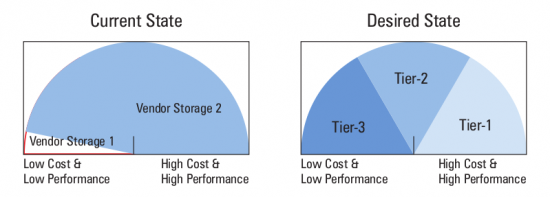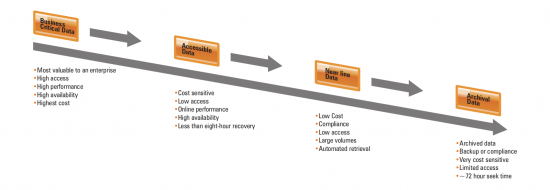Case Study – Implementation of tiering
In the case of a particular healthcare company, the data centre was consolidated on a single premium vendor’s storage platform. Due to market conditions and increasing pressure to cut IT budgets, the organisation was forced to look at ways to cut excess expenditure on operational costs. This drove the focus towards the business justification of expending premium storage for all applications, irrespective of their requirements. Hence, the management started to take care of new storage requirements on cheaper storage to balance the operational costs on the premier storage.
In spite of the presence of an adequate storage infrastructure, the company faced severe bandwidth issues for about seven of the 45 critical business applications. This was followed by lower utilisation levels on the storage, which was at an unusual level of 45 per cent. The existence of excess capacity as a result of application owners incorporating a 10-30 per cent buffer in their storage requirements over several years, contradicted the fact that the business applications faced availability issues.
This baffled the management and clearly pointed to the fact that there was no clear policy and methodology in place for treating applications’ requirements on the merit of their functional and non-functional requirements. The potential danger of risking downtime and data loss on business-critical applications prompted the management to take up a portfolio analysis, with the ultimate goal of creating a data life cycle management model for all the business applications through a tiered infrastructure [refer to Figure 2].

A data heat map traces the various phases of the data’s life cycle and the business value that it provides at various stages. This is an important tool to build an effective tiered infrastructure model, as it provides valuable information of the functional and non-functional requirements of the application data at various stages. This can then be aligned with the storage, server and the application infrastructure in the organisation to build the critical parameters governing the definition of the various tiers.
The identification of different categories of data and assigning them to the appropriate types of storage, play an important part in the storage infrastructure tiering, which reduces cost as well as optimises the performance levels required by the applications. Functional categories include the type of back-ups, retrieval, type of protection needed, availability requirements, and so on.
Non-functional attributes include performance requirements, frequency of usage of the data stored, and so on. The tiering process is ongoing and there are commercially available Storage Resource Management (SRM) applications that can be leveraged to achieve this. In the tiering activity, as illustrated in Figure 3, the different vendor storage platforms can be integrated to form a homogeneous pool of storage, using technologies such as virtualisation on top of which a tiered storage model can be implemented based on the criticality of data stored, performance requirements, etc.

For example, Tier 1 comprises business-critical data that has a high frequency of access and needs to be on premium storage that can address the high performance requirements of this type of data. Tier 2 data, which is relatively lower priority, may be stored on media that guarantee availability, but at a lower Quality of Service in conventional Storage Area Networks (SANs). Tier 3 is low priority data that is not frequently accessed [such as e-mail archives]. This type of data can be stored on cheaper storage where the performance requirements are less.
Key attributes to be considered when building a tiering model from a server perspective are the number of processors, availability of memory, number of I/O ports, etc. In a similar manner, application tiering can be achieved by separating business applications into multiple tiers based on functional parameters such as application binaries, criticality of data, etc, and non-functional parameters such as performance and the Quality of Service (QOS) needed.
Infrastructure tiering is a holistic capacity planning model that aims at assessing the current and future capacity requirements of a business’ IT infrastructure and determines a comprehensive tiered model to handle business applications in the most effective way. It is very important to be aware of all the building blocks of the infrastructure when designing a tiered storage model, without which the true benefits cannot be enjoyed.
















































































http://sourceforge.net/projects/ohsm/